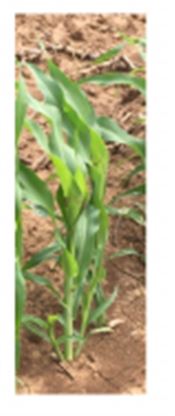|
Sorghum And Tillering
BRENT BEAN
LUBBOCK, TEXAS
Sorghum agronomists agree on many things; however, the one topic that always generates a debate is whether sorghum’s ability to tiller should be classified as a good trait or a bad trait. Regardless of a grower’s viewpoint in the debate, the fact is sorghum does tiller and must be accounted for in management decisions. Tillering, wanted or not, is influenced by three main management decisions: hybrid selection, planting date and seeding rate.
Tillering is considered a complex trait, meaning its expression in the field is regulated by the genetic makeup of the variety (G), the growing environment (E), the management practices (M), and the interactions of all three (G x E x M).

Although some varieties tiller more than others, the environment and management practices greatly influence the number of grain-producing tillers that are formed. Tillers primarily originate from four compacted nodes that are at or just below the soil surface. The amount of tillering that occurs is largely determined by temperature and the availability of resources, such as light, water and nutrients, soon after emergence. Resources are first made available to support growth of the main stalk. Then, once the main stalk's needs are met, any additional resources can be diverted to produce tillers. Growers should keep this concept in mind when considering management practices that affect tillering.
Temperature largely drives sorghum plant growth and is why heat units, or growing degree days, are used to predict when crop growth stages will occur. Planting date often determines how much heat is available to drive growth soon after planting. If sorghum is planted early, when soil and air temperatures are typically low, plant growth is slowed, resulting in less plant-available resources needed to support the growth of the main stalk. Under these conditions, tiller numbers per plant are higher, assuming light, water and nutrients are not limited. Alternatively, if sorghum is planted late, when higher temperatures are present, it promotes rapid main stalk growth, resulting in a reduction in the initiation and survival of viable tillers.
Conditions that promote rapid seedling growth tend to decrease the amount of tillering, as more resources are needed to support the fast growth of the main stalk. These conditions are adequate water, optimum sunlight interception by the leaves and favorable temperatures. Higher seeding rates will decrease tillering because there are more plants competing for available water and nutrients. In addition, leaf shading occurs when plants are closer together, reducing the amount of light being intercepted by each plant. Shading also likely affects plant hormones that are involved in tiller initiation.
So, back to the original question: Is tillering in sorghum good or bad? As is often the case, the correct answer is: It depends. Tillering can compensate for poor initial stands and take advantage of good environmental conditions to produce high yields. Conversely, when environmental conditions are poor, particularly post-sorghum bloom, tillering can lead to an unsustainable amount of biomass and potential grain numbers that cannot be supported by the available resources.
The debate continues. ∆
BRENT BEAN: USCP Agronomist

|
|